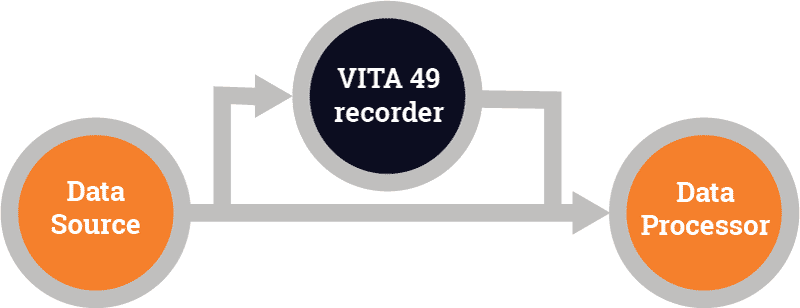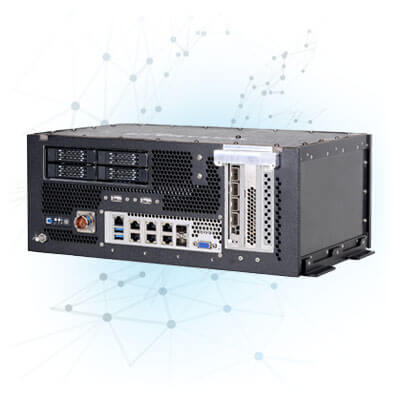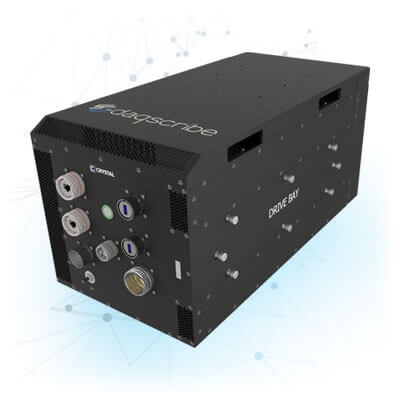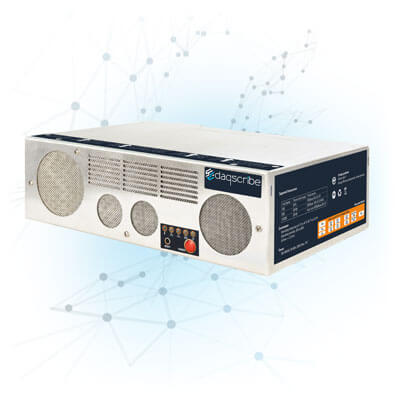Packet-based digital radios and Ethernet recording
Digital radios and the case for high-speed Ethernet packet recording before signal processing
“There’s an army of advanced wideband RF receiver manufacturers in the world
and most of them feature streaming digital radio packet output capabilities.”
The RF-digital receiver
There is no surprise that the end-to-end analog receiver (i.e., analog RF-in to analog IF-out) would necessarily evolve and feature digital frequency-output capabilities (i.e., analog RF-in to digital IF-out).

A typical VPX digital wideband receiver
Therefore, the development of the modern digital receiver as an integrated RF tuner and digitizer combination. These products effectively brought the analog world into the digital domain for reliable signaling transport and advanced signal processing-scheme opportunities.

General architecture of wideband RF receivers
The average consumer enjoys the power of the software-defined radio (SDR) in their pockets or as a technology embedded within their home entertainment systems.


Software-defined radio examples in common consumer electronics
SDRs enable smartphones and cable television appliances to offer advanced personal communication and entertainment experiences from the information the devices receive by radio. This is because the information encoded upon these signals can be easily manipulated within the digital domain instead of dealing with radio signals in their respective analog formats. There is also the reliable nature of digital communication systems, in that data can be transmitted over long distances with a very high level of accuracy and nominal precision.

Software-defined radio transceiver diagram
Digital radio + digital signal processor = software defined radio
The central component responsible for this technical wizardry is a digital signal processor or DSP. It is a type of computing device/system relevant to many industrial applications, including military and security systems development and production. A DSP system may turn digitized RF spectrum information into critical, real-time intelligence that can give a security force a tactical, operational advantage against lethal threats. In other cases, signal processing is a near-real-time or post information analysis process used for strategic defense planning and operations.
Digital radio with IF/baseband output, VITA 49 and Ethernet
A universal digital radio transport standard
Enter the VME bus International Trade Association (VITA) and the VITA Radio Transport standard (ANSI/VITA 49.0 or VRT) that includes a packet-radio protocol across many digital receivers and signal processing products. VRT effectively provides system interoperability and sustainability (e.g., maintenance and upgrades) by packetizing and transporting discrete radio information and contextual data in a uniform structure.
Standard ANSI/VITA 49.0 metadata examples
Device Identifier
Bandwidth
IF Reference Frequency
RF Reference Frequency
Gain
Sample Rate
Formatted GPS (Global Positioning System) Geolocation
State and Event Indicators
Analog receivers feature RF inputs and circuitry that facilitate signal mixing, tuning, filtering, and RF-IF conversion. The signal output from these receivers is typically a set of analog components manipulated and centered around a manageable frequency; otherwise, an Intermediate Frequency (IF) or a signal at baseband is employed. It is then the job of a high-speed digitizer – external or integrated – to convert the analog signal into a digital format.
There’s an army of advanced wideband RF receiver manufacturers globally, and most of them feature streaming digital radio packet output capabilities. The streaming data is transmitted in various formats and over a handful of data input/output interfaces with their associated physical transport layer-types. Examples include legacy Serial Front-Panel Data Port (sFPDP) and Serial RapidIO (sRIO) network technologies. The problem with many of these data transport schemes is they were often expensive and featured proprietary and exotic data formats.

Radio receiver architecture based on VITA 49.0
Ethernet Recorders Family
Browse our top selection of ethernet recorders below and request a quote to order directly online.
Have questions or need help? Contact us!
Signal process now, a little later, or much later:
the case for Ethernet recorders for packet-based digital radios
Ethernet’s apparent opportunity to both digital receivers and software-defined radios is the ability to dynamically route radio packets to processing systems via commercially available Ethernet equipment. Standard Ethernet protocols such as TCP, UDP, Multicast, and other schemes are utilized in most cases. And with more digital radio vendors producing products with larger spectrum bandwidths and RF channel densities, today’s Ethernet is ready with the ability to handle radio data-throughput rates up to 100Gbps.
A consequence of the greater data-rate capacities is that it produces substantial data sets that computer systems will ultimately be required to crunch. But throwing a “bigger wrench” at this problem is neither a straightforward nor practical solution. A DSP system’s processing power is proportional to its size, weight, power consumption, and cost (SWaP-C) specifications.
Signal recording and archiving for post-processing.
Be assured that given any supercomputer, large amounts of In-phase and Quadrature (I-Q) signal-data can be processed and then produce the most mathematically intensive real-time Falling Raster spectrum displays. But in most cases, installing a supercomputer aboard a SIGINT aircraft becomes impractical. Using this case example, integrating and deploying a low-cost Ethernet recording system for off-location signal post-processing (e.g., long-term or archive data storage) is a better alternative.
Near-real-time signals processing
In sticking with the airborne signals collection platform example, there is also a near-real-time processing opportunity where onboard DSP resources are limited. A recorder can have its recently stored radio data drawn when signal processors are busy or temporarily offline. The recorder effectively functions as a massive circular buffer, enabling “radio spectrum time machine-like” capabilities.

VITA 49 recorder between digital radio source and back-end processor

Agnostic Ethernet packet radio recording from Layer-2
Utilizing a protocol-agnostic Ethernet recorder would also be wise to assure compatibility with any digital radio manufacturer utilizing either proprietary or VITA49 data formats.

In the case of proprietary radio packet recording, the system should grab Ethernet data from Layer-2 (closest to the hardware layer) of the Ethernet stack instead of just capturing specific application or protocol layers. An Ethernet recording solution should assure 100% packet capture and recording of the streaming data at the total rate of the radio’s data-ports.

Data processing choices
In typical cases, data is transferred or removed from the recorder to external data processing systems. However, advanced Ethernet recorders now feature on-board, user-available data processing resources. Systems architects and engineers wishing to implement relatively simple data processing schemes closer to the radio/sensor interfaces will find value in options for additional CPUs, GP-GPUs, FPGAs, and memory on the high-speed packet recording platform.
Ethernet packet radio playback
A digital radio recorder should also have an option to accurately playback data to peripherals that could benefit from the direct injection of previously recorded packet data. For example, digital RF transceivers that feature DACs and up-conversion capabilities could be utilized to create unique RF stimulation and simulation systems.
Storage and data offload
A robust and reliable Ethernet packet recording system should recruit the best data storage options available. This often means using enterprise solid-state drives (SSDs) with a significantly higher performance than the standard and commercially available SSDs and HDDs.
A well-designed high-speed recording system will also need to monitor and manage the use-cycles of its storage devices. For example, it is essential to ensure that data is written evenly across the logical storage volume and each SSD device. The goal is to effectively optimize and extend the life of the otherwise expensive storage devices. A periodic status check of the drive’s temperature and read/write history is also helpful in determining the readiness of the recorder’s critical storage system.
Today’s Ethernet recorders offer scalable storage capacities in the hundreds of terabytes; petabyte storage recording systems have recently become available. But the apparent problem in the real-time and continuous data recording world is the transferring of large amounts of data from the system.
Many high-speed recording manufacturers accomplish this with one or two options.
- Removable Storage (e.g., removable disk packs)
- Incorporated high-speed network interfaces featuring 10GbE, 40GbE, and 100GbE-links
Another alternative most recorder manufacturers make available to systems engineers is the ability to mount the recorder’s standard file system (i.e., NFS) for limited but direct access to data that external processors demand.
Conclusion
Modern wideband receivers and radios have implemented RF-to-digital output capabilities. Manufacturers implemented various data transport schemes, including VITA 49, and they have wisely chosen Ethernet as the best data interconnect architecture.
Faster digitizers and high-speed Ethernet links have created opportunities for wider instantaneous bandwidths and increased channel capabilities. But It is not always practical to have significant and expensive computer systems on-board SWaP constrained platforms.
A relatively low-cost, high-speed Ethernet recording system is a reasonable alternative when and where near-real-time or post signals processing can be implemented in the information operation production process.




